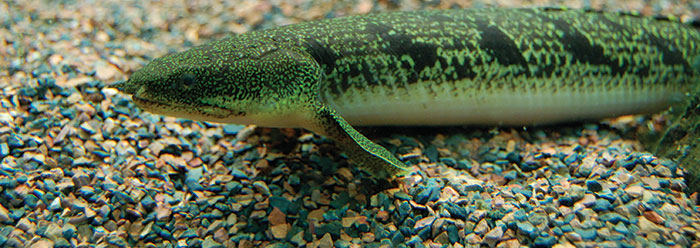The Lord Jesus unleashed His creativity when He designed fish. Some have numerous bones, others none. Many are streamlined, but a few are shaped like…well, rocks. Some even survive out of water. Flying fish glide on wave-top air currents far out at sea. Perhaps the wackiest fish are those that can live on land and breathe air. Each of these different and remarkable body designs showcases creation.
God equipped fish with different air-exchanging tactics. For example, the bowfin (a.k.a. “dogfish”) can live out of water for a long time by swallowing air into its swim bladder. But it uses gills, not lungs.
Three kinds of fish actually have lungs: gar, lungfish, and bichirs. Gar and lungfish breathe air with alveolar lungs like those of mammals and reptiles—lungs that exchange gases in tiny sacs called alveoli. Australian lungfish are unique and look like fossil lungfish from Devonian rocks, showing that no evolution occurred in the past 400 million supposed years. They have gills and one lung, which they only use when stressed.
South American lungfish look like African lungfish. These species probably descended from the same created lungfish kind and migrated toward their current habitats during or after the Flood. They need their small gills to release carbon dioxide, but they also need their lungs to acquire enough oxygen. With this unique design, how could lungfish have evolved? If their ancestor had no gills, it might have asphyxiated. But if it had not yet evolved lungs, how would it get oxygen?
Perhaps the Lord outfitted the first lungfish to thrive in shallow, oxygen-deprived waters, using this clever combination of gills and lungs. Or He could have built into the original lungfish the genetic potential to generate offspring that had both organs—an amazing technical feat. Try designing a machine that can refine certain components each time it copies itself!
New evidence shows that fish can refine their body parts within a single generation. Bichirs are African fish with non-alveolar lungs. Researchers recently raised 111 bichirs ranging from two-month-olds to adults in a terrarium.1 They kept others of the same age in an aquarium. The land-dwelling bichirs’ pectoral girdles—the bones just behind their heads—grew in proportions that enabled the fish to swing their heads farther from side to side when they awkwardly waggled on their front fins and flopped their long bellies behind. Their front fins also grew more directly below the chest, so as they propelled themselves along they slipped less often than their water-raised counterparts did when they tried to “walk.”
In the aquarium, bichir pectoral girdles were thicker, so they couldn’t waddle as efficiently—though they probably swam better. The evolutionists conducting the study speculated that these changes help explain how an ancient finned fish supposedly transformed into a leggy amphibian. Was it evolution or awesome design that changed the bichirs? Machines don’t alter their own components without being designed to do so.
As the juvenile bichirs grew up on land, tiny sensors probably detected stresses placed on their bones. Other cellular systems would interpret those inputs and send appropriate signals to bone-growth cells that deposited bone tissue into a more waddle-friendly arrangement.2
The Nature study authors who described their bichirs had to essentially ignore the extraordinary design behind these fish features when they hypothesized that the bichir changes they saw “may also facilitate macroevolutionary change.”1 What does a protocol that refines an existing structure have to do with the origin of such structures and protocols? Macroevolution requires nature to invent brand new body parts—something not yet demonstrated in nature or a laboratory. Optimizing a complicated support structure while it’s still in use clearly points to high-tech design—just the kind of features one would expect from a Creator who “created great sea creatures and every living thing that moves, with which the waters abounded, according to their kind.”3
References
- Standen, E. M., T. Y. Du, and H. C. E. Larsson. 2014. Developmental plasticity and the origin of tetrapods. Nature. 513 (7516): 54-58.
- Similarly, the bones of a tennis player’s racket arm are much thicker than her other arm due to stress-detecting and bone growth designs.
- Genesis 1:21a.
* Mr. Thomas is Science Writer at the Institute for Creation Research.









